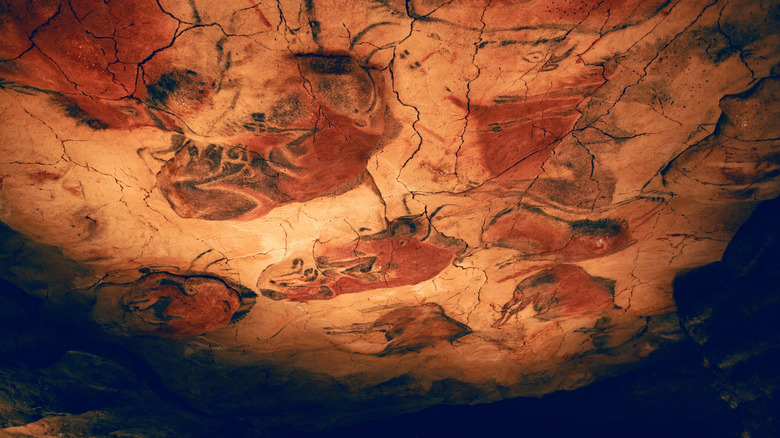The 'Sistine Chapel Of Prehistoric Art' Is A Stunning Set Of Cave Paintings Hidden On Spain's Green Coast
Few things are as humbling as witnessing the accomplishments of ancient peoples. Whether it's the Pyramids of Giza or their less-crowded, even older cousin, the Step Pyramid of Djoser, Cambodia's Hindu-Buddhist temple Angkor Wat and its 154-square-mile grounds, or the shockingly ornamented Duomo di Milano that took 500 years to complete, we've got a lot to live up to. But as old as these locations are, some archaeological sites are so ancient, and their craftsmanship so staggering, that they truly defy belief. Such is the case with the Cave of Altamira in Cantabria, Spain, the "Sistine Chapel of Prehistoric Art" that dates back to nearly 36,000 years ago.
The comparisons to Michelangelo's much, much later 16th-century masterwork in Vatican City aren't accidental. Far from being the blundering brushstrokes of some drooling cave dweller, the ceiling art at Cave of Altamira stands out because it's so sophisticated. The lines are graceful and confident, obviously stylized, and communicate the motion and vibrancy of the animals that they depict — birds, horses, deer, boars, and bison. There's a sense of life to the paintings, which were made from a combination of red ochre and charcoal. And far from being a one-time creative excursion, the paintings came in increasingly advanced artistic layers over 20,000 years of time, all the way up to about 15,300 years ago. Think about that the next time you think the 1980s were "a long time ago."
Unsurprisingly, the Cave of Altamira has been a UNESCO World Heritage Site since 1985. But most importantly for public appreciation, there's an on-site recreation of the cave available to visit. It only costs about $3.50, which, when combined with the chance to see Northern Spain, is a no-brainer deal.
Discovering Altamira Cave then and now
The story of the cave's discovery hints at how many other, similar Neolithic sites might be hidden across the Iberian Peninsula and beyond. And indeed, related sites have been found across Western Europe, like Chauvet-Pont d'Arc Cave in France, with its negative handprints — paintless cave wall handprints surrounded by red ochre. Amateur geologist and archaeologist Marcelino Sanz de Sautuola first stumbled across the Cave of Altamira in 1875, when his findings were limited to black paint and animal bones belonging to extinct species like wild horses, bison, and giant stag. It's when he went back in 1879 with his daughter, Maria, that she first noticed the ceiling paintings.
Originally dismissed by the scientific community, the archaeological site got a Board of Directors for its museum by 1924. The original museum resembled a Spanish countryside house more than anything, and it took until 2001 for the current facility to be built. Located off highway CA-134 in the Cantabria region, the cave's heritage center, administrative building, and walk-in recreation are all clustered together.
Folks wanting to visit the one-to-one recreation have to commit to the endeavor. You can get there from the closest, larger town, Santander, via somewhat cumbersome public transportation. But, that route thankfully passes through the cave's neighboring village, Santillana del Mar, a fairytale settlement of cobblestone and medieval architecture. The town is completely saturated with hotels, making things easier for long-distance visitors. And for folks with cars or who are feeling generally adventurous, you can always pair a trip to the caves with a visit to a Spanish town like the coastal fishing gem, Getaria, in the Basque Country.

